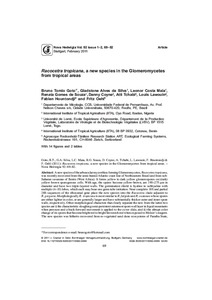| dc.contributor.author | Goto, B.T. |
| dc.contributor.author | Silva, G.A. |
| dc.contributor.author | Maia, L.C. |
| dc.contributor.author | Souza, R.G. |
| dc.contributor.author | Coyne, D.L. |
| dc.contributor.author | Tchabi, A. |
| dc.contributor.author | Lawouin, L. |
| dc.contributor.author | Hountondji, F.C.C. |
| dc.contributor.author | Oehl, F. |
| dc.date.accessioned | 2019-12-04T11:07:49Z |
| dc.date.available | 2019-12-04T11:07:49Z |
| dc.date.issued | 2011 |
| dc.identifier.citation | Goto, B.T., Silva, G.A., Maia, L.C., Souza, R.G., Coyne, D., Tchabi, A. ... & Oehl, F. (2011). Racocetra tropicana, a new species in the Glomeromycetes from tropical areas. Nova Hedwigia, 92(1-2), 69-82. |
| dc.identifier.issn | 0029-5035 |
| dc.identifier.uri | https://hdl.handle.net/20.500.12478/1607 |
| dc.description.abstract | A new species of the arbuscular mycorrhiza forming Glomeromycetes, Racocetra tropicana,was recently recovered from the semi-humid Atlantic coast line of Northeastern Brazil and from sub-Saharan savannas of Benin (West Africa). It forms yellow to dark yellow glomerospores on (dark) yellow brown sporogenous cells. With age, the spores become yellow-brown, are 190–275 μm indiameter and have two triple-layered walls. The germination shield is hyaline to subhyaline withmultiple (4–10) lobes, which each may bear one germ tube initiation. Near complete 18S and partial28S sequences of the ribosomal gene place the new species into the Racocetra clade adjacent toR. gregaria. Morphologically R. tropicana is most similar to R. fulgida and R. castanea whose sporesare either lighter in color, or are generally larger and have substantially thicker outer and inner sporewalls, respectively. Other morphological characters that clearly separate the new from the latter two species are i) the characteristic sloughing semi-persistent outermost spore wall layer in liquid mountants when pressure and a back-forward movement is applied to the cover slide, and ii) the abrupt color change of its spores that become bright red to bright brownish-red when exposed to Melzer’s reagent. The new species was hitherto recovered from re-vegetated sand dune ecosystems of Paraíba State, Brazil, and from undisturbed savannas, traditional crop production systems and a long-term fallow in Benin but was not recovered from land following intensive agricultural use. |
| dc.description.sponsorship | Conselho Nacional de Desenvolvimento Científico e Tecnológico |
| dc.description.sponsorship | Fundação de Amparo à Ciência e Tecnologia do Estado de Pernambuco |
| dc.description.sponsorship | Swiss Center for International Agriculture |
| dc.format.extent | 69-82 |
| dc.language.iso | en |
| dc.subject | Gigaspora |
| dc.subject | Scutellospora |
| dc.subject | Racocetra Tropicana |
| dc.subject | Glomeromycetes |
| dc.subject | Tropical Areas |
| dc.subject | Arbuscular Mycorrhizal Fungi |
| dc.subject | Soil Sampling And Soil Parameters |
| dc.subject | Dna Extraction |
| dc.title | Racocetra tropicana, a new species in the Glomeromycetes from tropical areas |
| dc.type | Journal Article |
| dc.description.version | Peer Review |
| cg.contributor.affiliation | Universidade Federal de Pernambuco |
| cg.contributor.affiliation | International Institute of Tropical Agriculture |
| cg.contributor.affiliation | Université de Lomé |
| cg.contributor.affiliation | Agroscope Research Station, Switzerland |
| cg.coverage.region | Africa |
| cg.coverage.region | South America |
| cg.coverage.region | West Africa |
| cg.coverage.country | Benin |
| cg.coverage.country | Brazil |
| cg.isijournal | ISI Journal |
| cg.authorship.types | CGIAR and developing country institute |
| cg.iitasubject | Plant Diseases |
| cg.iitasubject | Plant Genetic Resources |
| cg.iitasubject | Soil Surveys And Mapping |
| cg.journal | Nova Hedwigia |
| cg.howpublished | Formally Published |
| cg.accessibilitystatus | Limited Access |
| local.dspaceid | 82394 |
| cg.targetaudience | Scientists |
| cg.identifier.doi | https://doi.org/10.1127/0029-5035/2011/0092-0069 |

